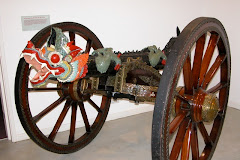Unfortunately, it was hard to make an opening that could be tightly sealed before firing the gun. Gas under high pressure will escape out of every tiny crevice and since it was both extremely hot and highly corrosive, it wore away metal and made the holes larger. It also made the gun very dangerous to operate! It soon became apparent that it would be better to stay with the original idea of a tube with only one opening (at the muzzle) and to load the ammunition from that end. This required only one small hole at the breech end in order to let in the flame that would light the propellant and fire the gun. This 'vent' was subject to the same problems of corrosive wear, of course, and needed to be repaired from time to time.
.jpg)
Muzzle loading had its dangers, too. After firing there was almost always some hot residue in the chamber - i.e. the breech end of the barrel, where the ammunition is placed. There was a risk that the next charge of propellant pushed down to the chamber would ignite prematurely and injure the gunner who was loading it. There were two basic precautions taken against this: one was to swab the bore with a wet sponge; the second was to cover the vent hole with a large thumb while the propellant was being loaded. This prevented a flow of air being created by the ramming of the propellant and the fanning of any residue of spark into flame.
Breech loading was resurrected in British artillery in the 19th Century when multi-groove rifling made it very difficult to load ammunition from the muzzle end. Various designs were tried, but it was the design by William Armstrong that was adopted in 1858. This had a 'breech block' that could be lifted out to allow ammunition to be loaded into the chamber of the gun. When replaced, a screw mechanism pushed it tight against the rear face of the barrel and sealed it - a process known as 'obturation'. This block contained the vent for firing.
Later designs also used a breech block, but they were sliding blocks, sometimes operated horizontally, but mostly vertically. These incorporate the firing mechanism, usually a percussion mechanism like that used in a small arm. The striker in the mechanism either fires a small cartridge that sends hot gases into the propellant, or activates a priming tube in the base of a cartridge that holds the gun's propellant. (Note that, depending on the design of the gun, propellant can be loaded either in bags or contained in a large 'brass' cartridge case.)
Despite Armstrong's achievements, the higher cost of rifled breech loaders (RBL) caused the authorities to revert to muzzle loaders (RML) for some 20 years, albeit with a rudimentary rifling system based on fewer grooves and projectiles with projecting studs. (See a later article on aspects of rifling.) Eventually, designers reverted to RBL and that is how most guns in service use are designed today.




No comments:
Post a Comment